.jpg) BBQ Ribs
BBQ Ribs
2 slabs baby back pork ribs
1 can fried tomato purée
1 white onion
3 garlic cloves
1 teaspoon hot paprika
1 teaspoon ground coriander
1 teaspoon ground cumin
1 glass molasses (or honey)
1 glass apple cider vinegar
2 spoonfuls Perrins sauce
Extra virgin olive oil, salt and pepper to taste
My favourite recipe for pork ribs includes macerating overnight in porter beer with thyme and heather honey. That is a true delicacy, but we are talking about traditional American dishes, so let’s cook real “Ribs”.
Many BBQ restaurants use industrial sauces or a simple mix of ketchup, cider vinegar and Perrins sauce, or even soya sauce, but we are going to be orthodox and cook a high-level BBQ sauce.
Start by making a traditional stir-fry with the onion, finely chopped, and the garlic cloves. When it goes brown, add the can of fried tomato and the vinegar. It must boil for a while so that the acetic acid evaporates from the vinegar (it feels itchy in the nose). Then, add the spices, Perrins sauce, honey or molasses, salt and pepper. Don’t be shy with the salt, as it is the only salt the ribs will have at all.
That blend is a suggestion, but personal variations can be made. For example, you may use Tabasco sauce instead of paprika, or even chilli peppers –chipotles, serranos or others. You may also add chutney or some fruit, either fresh or canned, such as tamarind, mango or orange peel.
Bring the mix to the boil and check the texture –it must be a bit like syrup.
Pass the mixture through the blender and leave to stand.
Dip the ribs in the sauce and leave it overnight, moving it from time to time so that it gets totally seasoned.
The ideal way of roasting the ribs is on a wood barbecue, turning them over regularly and painting them with a brush dipped in the sauce.
If there is no barbecue available, they can be roasted in the oven at 170ºC for a couple of hours, putting sauce on both sides every thirty minutes.
.jpg) California Roll
California Roll
100grs. sushi rice
100 grs. spider crab meat
1 ripe avocado
1 cucumber
1 can flying fish roe
Toasted sesame
Fusion food? It was, originally, since it was created by a Japanese cook living in Los Angeles, Mashita Ichiro, who designed this maki-sushi adapted to Californian tastes in his restaurant Tokyo Kaikan. It has become a universal dish: even in Shanghai there is a restaurant specialized in California Roll.
The mise en place is very important: everything we are going to use must be carefully placed as if on an operating table.
Prepare some gohan (white rice dressed for sushi) and reserve it on a bamboo basket, covering it with a wet towel.
Lay out some nori seaweed leaves on the working table, the clean crab meat in a bowl, the cucumber, cut in strips in a bowl with icy water, sliced avocado, sesame and flying fish roe on small trays.
Cover your rolling mat with plastic wrap to prevent the rice grains from getting stuck to the bamboo sticks.
Lay out a seaweed leaf on the working table, place some gohan rice on it and, with your hands wet with warm water, spread it on the leaf until you get a layer about 1 cm. thick. It is useful to have a bowl with warn water at hand to keep your hands wet.
If you have compacted the rice with your hands well, you will be able to manipulate it without any risk. Place it on the rolling mat but upside down, that is, with the seaweed facing top. That is the most difficult step, but it can be made easier if you place the mat on it before turning it upside down, or by placing the seaweed and the rice on a piece of plastic, paper or aluminium wrap.
Put a strip of shredded crab meat on the seaweed (some people use surimi, but that is rubbish), together with a strip of cucumber from end to end and avocado slices, so that you can see the centre of the seaweed fully covered with these ingredients.
Now you will undergo the next skill test. Roll this with the aid of the mat, holding it tight but not letting it come out through the extremes. When you feel it compact enough, place the roll on the table, cut it in halves and put some roe on them –some cooks make them roll on the hoe to cover them completely, but I think that a bit is enough. Place the halves side to side, sprinkle toasted sesame on them and cut each piece in halves, and then in halves again, so that there will be eight pieces. Keep in mind that they must be bite-size pieces.
.jpg) Chiles en nogada
Chiles en nogada
8 green peppers (Italian or from Málaga)
50 grs. almonds
50 grs. walnuts
4 eggs
Wheat flour
½ litre liquid cream
100 grs. fresh goat cheese
1 onion
5 garlic cloves
50 grs. currant grapes
50 grs. dried peaches
1 apple
1 pear
200 grs. meat, 50/50 pork and beef
1 pomegranate
Fresh leaves of parsley, coriander, mint or any other herbs you may like.
This is one of the most valued dishes by Mexican gourmets, and they are quite right because it is a haute-cuisine dish with delicious results.
This dish has got history in it, as it is said to have been designed by the nuns at Santa Mónica convent on September 27, 1821, to welcome Emperor Agustín de Iturbide in Puebla and so celebrate the independence of Mexico.
This dish is difficult to cook; the ingredients list may seem exaggerated, but it is actually a lighter version. The original recipe has got three times as many ingredients as this one.
Firstly, roast the peppers in the oven or, even better, over hot coals. Once singed, cover them with oven paper, allow them to cool, peel them, remove the pips, split longitudinally and set aside.
For the filling, sauté the chopped onion with the garlic and add the fruits and the meat. Allow to sweat to eliminate excess water.
For the sauce, crumble the cheese and heat it with the cream and the nuts, previously fried and crushed –use a mincer or a chopper, as they must be hardly seen.
Beat the egg whites until they are stiff and beat the yolks separately. Stuff the peppers and secure each one with a toothpick. Dip them in the yolks, then in flour, then in the whites and fry in plenty of oil until they become gold coloured.
Serve the ingredients hot, covering the peppers with the sauce and garnishing them with pomegranate grains and green leaves (I love the fresh and spicy taste of spearmint, but in Mexico it is customary to use coriander or curly parsley), trying to reproduce the colours of the Mexican flag as those nuns did.
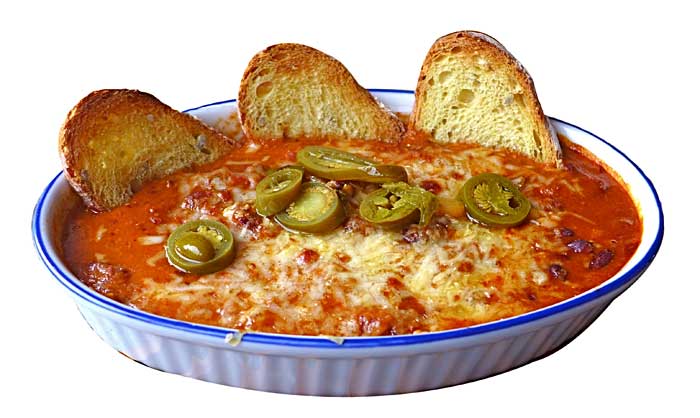 Chili
Chili
½ kilo red beans
½ kilo minced pork meat
2 onions
2 red peppers
2 carrots
6 garlic cloves
6 red chili (chipotles)
2 large tomatoes, very ripe
6 chiles chipotles (fresh or canned)
50 grs. black chocolate (70% cocoa)
Coriander, cumin and oregano
In that difficult border that unites or separates Texas and Mexico, we have this Mexican-style recipe, but it does not come from Puebla, Oaxaca or Veracruz, but from the border states, because nobody can be certain if it belongs to one country or the other. In cooking terms, pure Tex-Mex. If we take into account that California, Arizona, New Mexico and Texas, the four southern border states, were first Spanish then Mexican until the middle of the 19th century, we can understand this blend of cultures.
A thousand brands of canned chili con carne can be found in the American market, as it is a usual meal in USA, but it is worth taking the trouble to cook this stew. You will enjoy it.
As required, soak the beans overnight in mineral water. It must be low in calcium so that they do not peel off.
Prepare a stir-fry with the onion, the garlic, the carrot and the red pepper. When it gets tanned, pour it in the pot with the beans and their water. It is advisable to cook them in a pressure cooker for fifteen minutes, then leave it to cool until it can be opened and continue cooking at atmospheric pressure.
Prepare a similar stir-fry in a large frying pan (it can be the same, using a half for the beans and the other half for the meat). When it gets tanned, add the tomatoes, peeled and without the seeds, the chilli peppers and the spices. Either fresh or canned chilli peppers can be used but be careful with how spicy they are; the stew must be hot but not too much. The stir-fry must be slightly sweet, so add a spoonful of cocoa, mole or black chocolate.
Once the water excess is eliminated, add the meat, season it generously and stir.
Add the mixture to the beans when they are soft and allow it to boil until it gets creamy.
Do not add any more salt until it is done, because there is no going back if you put too much in it. Taste it for spice, taking into account the diners’ tastes. If necessary, chopping some canned chipotles and serving them as a side dish for those more used to spicy food is a good solution.
It is customary in most TexMex restaurants to put a layer of Cheddar cheese on top and grill it for a few seconds. Some cornbread chips can be seen in the picture.
(1).jpg) Grilled lobster
Grilled lobster
2 lobsters about 1 kg./1,5 kg.
100 grs. salted butter
Corn oil
Chive
Parsley
Sorrel
Savory
Lemon verbena
Spearmint
The picture shows a clawed lobster, not what we would call a lobster, but Americans do not difference between them, they are both usually called lobsters.
Tons of lobsters are consumed across the USA, not only in the coast areas where they are reared in culture but everywhere. For example, the most famous restaurant in Cincinnati, 700 km. from the sea, is called “Red Lobster”.
It is an eminently French recipe, what they call Homard au beurre persillé -fines herbes, herbes de Provence, perfumé… The difference is that this recipe does not have garlic in it, since this ingredient is not customarily used in American haute-cuisine.
It is advisable to know the diners’ tastes before you prepare the butter, because many delicious and aromatic herbs can be used, such as fennel, dill, tarragon, cumin or coriander, but if someone finds any of them unpleasant, take it off or you will spoil his/her meal. An ideal blend would be chive, sorrel, coriander and tarragon, but some people may dislike it.
The butter must be malleable but not liquid, at about 20ºC. Chop finely the herbs (always fresh), mix them with the butter until the mixture is homogeneous and keep it in the fridge.
When the grill embers are ready, split the lobsters in two halves and place them on the grid, with the open side facing up. You may spray some corn oil on them, but it is not essential. When the meat gets white, turn them upside down so they get the taste from the embers and get marked by the grid rods.
Serve them facing up, with some little balls of the prepared butter on them. It will melt immediately but it will reach our mouth with all the freshness from the herbs.
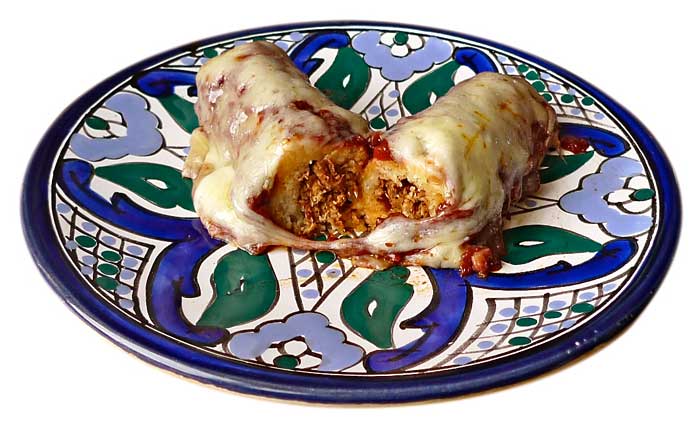 Grilled tamales
Grilled tamales
For the tamales
1/2 kg. corn flour for tamales
1/2 kg. lard
1 spoonful baking soda
1/2 litre warm chicken bouillon
Salt
1 package corn leaves
1/2 kg. fresh manchego cheese
For the "mole"
1 onion
3 garlic cloves
1 carrot
2 ripe tomatoes
1 red pepper
50 grs. fried peanuts
1 spoonful cocoa
1 clove
1 cinnamon stick
This is a very complicated dish to cook. On practically every corner in any street in Mexico you can find women with a couple of buckets full of homemade tamales, wrapped in leaves. They are sold cheaply and are delicious as they are, but you can also take them home and give them a more sophisticated preparation like this one, with mole and melted cheese.
There are preserved tamales in the market, both canned and in metalized envelopes with inert gas, but they are not easy to find in all provinces in Spain, so we are going to cook homemade tamales.
It is essential to get corn flour for tamales: make sure that it is specified in the package because it is impossible to get this preparation at home -it even contains some kind of ashes and lime that I could not describe.
Beat the lard as if you were whisking egg whites to form stiff peaks. It will take quite a long time, even with an industrial mixer, so if you use a wire whisk your arm will suffer until the lard is transformed into foam. It is a bore but it is essential.
The corn leaves must be soaked for quite a while to make them flexible. If not, we will not be able to wrap the tamales.
Mix the flour with salt and baking powder in a bowl -baking powder is the most similar thing to tequesquite, impossible to find in Spain.
Stir well the mixture and mix it, little by little, with the lard foam. It must be totally homogeneous. Then add the chicken bouillon, which must be at the same temperature, and beat until the dough gets uniform.
Now let's make the stuffing.
Tamales can be stuffed with anything we like: guajolote (turkey) mole, chicken with green mole (chilli), even what is called there rajas" which can be jalapeños or poblanos chilli. The latter are the tastiest, but we are going to use them to finish the dish, so we can use chicken in green sauce -this is made by boiling green pepper with jalapeños, but it can be purchased readymade. The meat can be the leftovers from a roast chicken, or you may simply boil a chicken breast.
Spread a portion of the dough on a corn leaf, add some shredded meat and put some green sauce on top. Wrap it with the leaf, folding the empty part on the stuffed one. Make as many as you can and place them in a steamer. Put a couple leaves on the bottom and place the tamales on them so that they support one another. Put two more leaves on top and cover with a wet napkin. Close the steamer and cook for one hour. Take one tamal out and check that the dough has set. The tamales are now made.
For the sauce, make a stir-fry with the vegetables, very thinly chopped - in mirepoix as it is called-, with the spices. Once it is done and quite dry (a bit of bouillon can be added), sprinkle the cocoa and stir well until it is completely dissolved. Take out the cinnamon stick and pass the sauce through a Chinese strainer.
To finish the dish, spread some mole on the baking tray, put the tamales on it –without the leaves-, cover them with mole and sprinkle the cheese on top –crumble it with your fingers. Bake in a hot oven (220ºC) until the cheese starts to brown and serve.
.jpg) Hamburger
Hamburger
¾ kilo beef meat
¼ kilo pork meat
2 eggs
Spices
It may sound like a truism, but the world of hamburgers in USA is a whole culture, almost a way of living. Not only are there large chains of restaurants that specialize in them –not synthetic McDonald’s-type but quality ones- but every family has got their specialties cooked on their garden barbecue at weekends, holidays and family gatherings.
The three key ingredients are the quality of the hamburger itself, the fire and the side dishes.
The ideal fire is a grill with dry holmoak or mimosa wood, but the possibilities in each home are limited.
Each side dish is a recipe itself, but my favourites are baked potatoes with sour cream and the cabbage salad called coleslaw.
In Spain, quality products for hamburgers are already available. In fact, it is easier to get a good quality red meat hamburger already prepared than to find this meat in butchers’ shops, since it is usually reserved for restaurants.
The proportion of meat indicated must be respected because pork meat provides fat that gets melted when cooked, making the piece juicier.
Each cook has got a favourite blend of spices, usually a family secret. This is my suggestion: smoked salt, sweet paprika, chilli powder, white pepper, celery seed, ground ginger, dry mustard and dill. It is very orthodox blend and none of the spices can be perceived individually, it just enhances the flavour of the meat spectacularly.
Mix the meat with the spices and the beaten eggs, leave the dough to stand for a couple of hours and shape the portions according to each diner’s taste: some people prefer them one pound in weight, almost raw inside, others like quarter pound burgers, like the industrial ones.
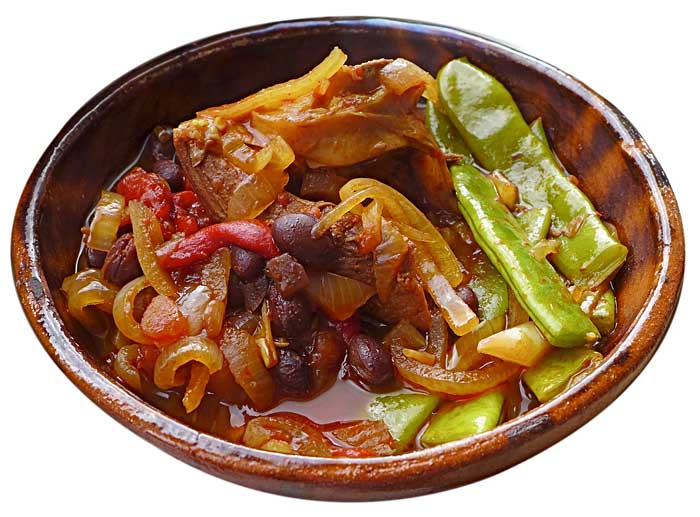 Huajuapan mole
Huajuapan mole
2 kg. kid rump meat or 1 kg. paschal (older) lamb
1 can piquillo peppers
2 spoonfuls ñora meat (spiced red peppers)
1 chilli pepper
1 onion
2 lemons
1 head of garlic
1/2 kg. green beans
1 can black beans
1 can fried tomato sauce
1 bay leaf
1 spoonful hot paprika
1 spoonful sweet paprika
1 bunch of fresh coriander
Also known as “Mole de caderas” or “Mole de chivo” (young goat), this dish is a matter of rivalry between the states of Puebla and Oaxaca, specifically the cities of Tehuacán and Huajapán de León, where there are multitudinous festivals in which more than 30000 animals are slaughtered, which gives us an idea of the magnitude of the event.
This dish is very different from what we usually know as “mole”; it is almost a meat soup with vegetables but with surprising flavours.
As you can see, the list of ingredients is huge, however we have had to make some changes because the traditional recipes have some ingredients that can only be found there, for instance "ejotes", which had to be replaced by green beans - the most similar ingredient we found.
The first step will be to season the meat, which will be paschal lamb as I suppose Oaxaca kid will not be available. Season the meat in pieces with both paprikas and the juice from the lemons, and leave to marinate overnight.
The following day, put the meat in a large pot together with the canned peppers, the ñora meat, the garlic, the tomato sauce and the bay leaf. Cover with water and bring to the boil. Once it is boiling, lower the flame to medium intensity (6/10) and cook for more than one hour, until the meat is reasonably soft.
Leave it to stand for one more night so the flavours can blend and some ingredients get oxidized, achieving a deeper and warmer taste.
The following day, add the black beans, the onion in slices and the green beans (previously washed and split). Cook until the beans are edible (not too soft). Chopped fresh coriander can be either sprinkled when the dish is served or served on the side in case somebody does not like this spice.
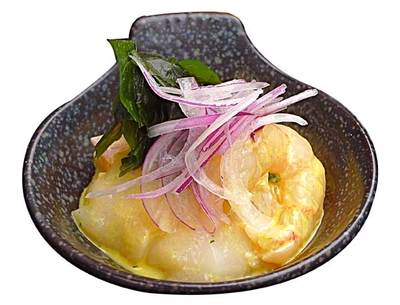 Mixed Ceviche
Mixed Ceviche
½ kg. clean sea bass
4 scallops
4 raw prawns
2 limes
1 red onion
1 bunch coriander
2 spoonfuls yellow chilli pepper
Ceviches have become fashionable in our capitalist, gourmet, Western world. Every day we can see creations that take the word to absurd extents, such as the “Tomato and onion ceviche with extra virgin olive oil”, that is, simple tomato and onion salad.
Real Peruvian ceviche is made with “corvina campera” (Scianea gilberti), one of the most valued fish in that coast for its fine and soft meat. In Europe we have another species (Argyrosomus regius), a bit different but also delicious.
An orthodox variation is the mixed ceviche with sea bass and seafood, which is usually used in ceviches, especially some large prawns called “camarones” there. It is important to check their freshness or, if they are frozen, their traceability, since they are going to be consumed raw.
A usual mistake is to cut the fish into thin slices carpaccio-style. It is essential in ceviches to be able to taste the raw fish differentiated from the dressing, as well as its texture; you have to feel the bite.
Watch the fish carefully when you cut it in case it has got anisakis. To prevent this, it can also be frozen for a couple of days, which will hardly affect its texture.
Only the white part of the scallops –the muscle- must be used. Splitting each one in four pieces will help taste its sweet flavour.
Take the dorsal cord off the prawns. It may contain sand and even bacteria.
Once the three ingredients have been prepared, squeeze the limes and mix the juice with the yellow chilli pepper and the chopped coriander (this is optional as some people can’t stand it). Pour this sauce on the fish and seafood, stir up and serve immediately with thin slices of red onion, julienne-style.
Some cooks leave it marinating for some minutes or even hours, but the dressing is so strong that it will override the taste of the fish and seafood.
.jpg) Snow crab salad
Snow crab salad
4 snow crabs
1 lettuce
4 sticks green celery
½ litre mayonnaise
Dijon mustard
1 lemon
The tradition of consuming crabs in USA dates back to the first settlers, who used them in soups and stews, or simply grilled over hot coals. Nowadays, it is an industry that moves thousands of tons of crab meat, there are specialized restaurants and multitudinous gastronomic events are held, such as the famous Chesapeake blue crab feasts, immortalized by great Jack Nicholson’s movie As Good as It Gets.
Among the hundreds of varieties that are consumed in both coasts, the one with a highest quality is the Snow crab (Chionoecetes opilio) –not to be confused with Royal crab (Paralithodes camtschaticus), also fished in the Bering Sea, larger but less fine and tasty.
Snow crab salad is a dish with a clear influence of French cuisine and most appetizing but expensive. Anyway, it does not reach the level of our Galician Spider crabs.
Only cells and legs are commercialized, boiled and deep-frozen, so you only have to leave it to defrost as slowly as possible to keep the meat smooth. Then, break the shell with a hammer and put the meat in a bowl. The biggest pieces of meat must be set aside to garnish the finished salad. Mix the rest with mayonnaise, scented with Dijon mustard and some drops of lemon juice.
Make a bed with the lettuce cut in julienne strips and little celery sticks. Put the mixture of mayonnaise and crab on it and garnish the dish with the bigger parts of the meat from the legs to make it more attractive.
This is undoubtedly the great American meal, their signature dish since this day was declared national holiday by Abraham Lincoln in 1863. The early settlers, known as the Pilgrims, celebrated this day as far as in 1620 with turkey, which is a native of this continent, and they must have stuffed it with fruit, since it is a very dry, even quite tasteless bite.
There are a thousand recipes, as usual with traditional dishes, from those involving a microwave oven, frozen turkey and all types of industrial preparations, to the most sophisticated ones, which seem taken from a medieval recipe book but within the limits of a gourmet’s decency. All of them are suitable for this pairing, and when people in America try it, they will certify it as compulsory as corn cobs and cranberry sauce.
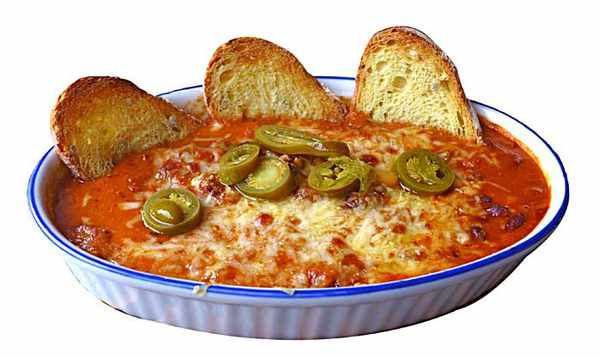
![]() Pueden ver la versión española pinchando en Recetas americanas.
Pueden ver la versión española pinchando en Recetas americanas..jpg) BBQ Ribs
BBQ Ribs
.jpg) California Roll
California Roll
.jpg) Chiles en nogada
Chiles en nogada
 Chili
Chili(1).jpg) Grilled lobster
Grilled lobster
 Grilled tamales
Grilled tamales
.jpg) Hamburger
Hamburger
 Huajuapan mole
Huajuapan mole
 Mixed Ceviche
Mixed Ceviche
.jpg) Snow crab salad
Snow crab salad
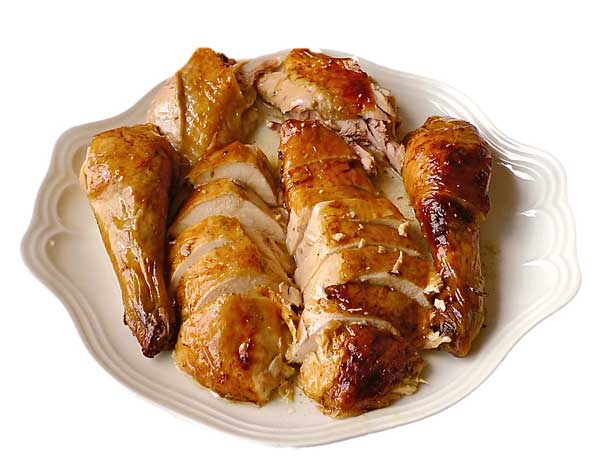 Thanksgiving turkey
Thanksgiving turkey












